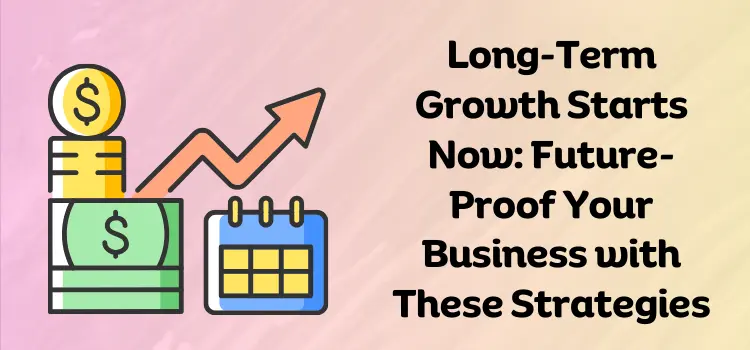
We all understand that the future is highly unpredictable and that a game can change in the next few seconds. While we cannot control the future, we can equip ourselves to handle it effectively. You have spent years and years of hard work on our business to stand out from the crowd. Therefore, you cannot risk losing the value of all the sweat and hard work in one go.
Future-proofing your business is not just about predicting the next big move but also about setting a strong foundation that can easily withstand unexpected disruptions. For today’s businesses, short-term success is no longer valuable. You have to now adapt, evolve, and grow your business over time.
A company that fails to future-proof its strategies fails to stay competitive in the ever-changing market. In this blog, we will look at the key strategies that you can follow to future-proof your business and achieve long-term growth. By implementing these strategies, you can ensure that your business remains relevant and successful in the face of constant change and certainty.
- Invest in Technology and Digital Transformation
Through the use of cutting-edge technology, digital transformation improves company operations, consumer involvement, and data-driven decision-making. Technologies such as the cloud, AI, automation, and the IoT are essential to digital transformation. Businesses may simplify their processes, increase their productivity, and provide more customized experiences for customers with the help of these technologies.
To illustrate the point, AI chatbots may respond to consumer requests around the clock, eliminating the need for human agents to address more complicated matters. In a similar vein, automating mundane but necessary processes can increase output while decreasing human error and freeing up workers for higher-level, more strategic endeavors.
Thanks to cloud computing, businesses can safely store all of their data and apps in one online area. This makes all of that information accessible from any location, allowing employees to work remotely and collaborate more efficiently. In addition to lowering operational costs, the cloud eliminates the need for expensive in-house infrastructure. Through device connectivity, real-time data collection, and improved management of corporate activities, the Internet of Things (IoT) can also enhance operational insights.
An effective digital strategy increases a company’s chances of growth and profitability by 2.3 times, according to McKinsey. In addition to improving day-to-day operations, companies that embrace digital transformation are better equipped to respond to future developments and keep up with the ever-changing market.
- Embrace a Fail-Fast, Learn-Fast Approach
To foster innovation and adaptation in companies, the “fail-fast” method advocates for rapid experimentation and learning from mistakes. This kind of thinking pushes workers to try out new things frequently, see failure as a necessary component of learning, and use what they’ve learned to improve their methods. Businesses with a fail-fast mentality don’t dread making mistakes; they see them as chances to improve. This new way of thinking encourages a mindset of constant development, which is crucial for keeping up with dynamic marketplaces.
Notable proponents of the fail-fast strategy include Google and Amazon. They encourage teams to explore without fear of negative consequences in a “test-and-learn” atmosphere. Consider Amazon, which annually launches a plethora of small projects, fully aware that only a fraction of these will achieve success. However, when some of these initiatives succeed, such as Amazon Prime and AWS, they often become catalysts for further growth and expansion.
Companies that practice fail-fast are better able to change course quickly in response to changing customer demands and market conditions. An agile and responsive architecture allows firms to modify products or strategies based on client feedback, which in turn reduces the likelihood of massive failures. The Harvard Business Review claims that teams can learn to incorporate input into each iteration and improve products in real time by adopting a fail-fast culture. This, in turn, can lead to more substantive and impactful innovation.
- Build a Strong, Purpose-Driven Brand
Businesses with a purpose aim to do more than just make money; they build a reputation for themselves based on principles that matter to their consumers and workers. Companies may engage with their customers on a deeper, more genuine level when they link their objectives with larger social or environmental problems.
Employee engagement tends to be higher in purpose-driven firms. A company’s mission statement can inspire its personnel to go above and beyond in their work. Research from Deloitte indicates that workers who invest in the company’s mission are more likely to be satisfied with their work and put in extra effort. This, in turn, fosters an environment where everyone can thrive in the long run. On top of that, businesses with a mission can entice people who are eager to make a difference, which in turn helps cultivate a dedicated team that shares the vision of the company.
- Plan for Scenario-Based Risks
When businesses engage in scenario planning, they make an effort to foresee and prepare for a wide variety of possible future events, such as changes in regulations or economic conditions as well as natural disasters or technological upheavals. This kind of planning allows companies to be ready for any kind of change that may come their way.
The process of scenario planning entails generating potential “what-if” outcomes, assessing their potential effects on the company, and then developing responses to these potential problems. Organizations can strengthen their resilience in real-world scenarios by learning about their strengths and weaknesses through simulations of various futures.
Jonathan Brill introduces the concept of “rogue wave” planning in his book Rogue Waves. This type of planning targets low-probability, high-impact occurrences that can have a significant influence on a company’s operations. When numerous minor occurrences come together and have an amplified impact, it can cause unexpected disturbances known as rogue waves.
Scenario planning is a powerful tool for preventing threats and capitalizing on opportunities. By anticipating a wide range of outcomes, organizations can sustain growth, respond quickly to changing market demands, and invest in promising new areas. Thus, scenario planning is crucial for companies that want to secure their operations for the future, so they can remain competitive, flexible, and ready even when faced with uncertainty.
- Focus on Customer Experience and Engagement
In a highly competitive market, it is absolutely essential for businesses to provide outstanding customer experience (CX) since it has a direct bearing on customer loyalty, retention, and brand reputation. One of the most important ways to provide excellent CX is to personalize offerings to each consumer.
Businesses are able to provide customers with personalized content, suggestions, and services according to their tastes and previous actions thanks to data analytics and AI, which are driving personalization. Businesses can learn more about their customers’ buying habits and preferences through data analysis, which in turn helps them provide better, more tailored service.
Aggressively seeking out client input is another essential component of CX. Fast problem resolution and enhancements that increase client loyalty are the results of proactive customer engagement and response to consumer concerns. In addition to increasing customer happiness, this feedback loop also aids companies in responding to customers’ evolving expectations through innovation and adaptation.
Read Also:- The Blueprint to Long-Term Business Success
Conclusion
To sum up, if you want your organization to be ready for the future, you need to take proactive measures, such as embracing digital transformation and technology and encouraging innovation through a fail-fast, learn-fast mentality. Businesses that create brands with a purpose, anticipate risks, and prioritize the customer experience have a better chance of succeeding in unpredictable markets.
Businesses can secure long-term growth and maintain competitiveness by consistently responding to changes in the market, making use of new technology, and aligning with customer expectations. Achieving both short-term success and long-term sustainability requires adaptability, resilience, and a readiness to change when faced with adversity. To safeguard your company from the unknowns of tomorrow, invest in these measures now.


